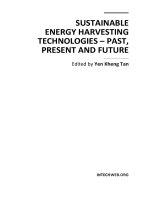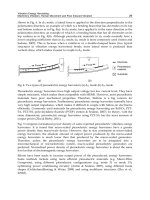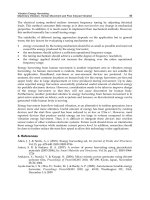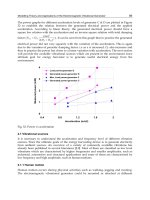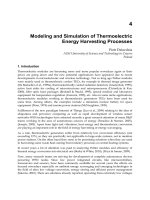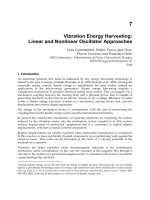Sustainable Energy Harvesting Technologies Past Present and Future Part 1 pot
Bạn đang xem bản rút gọn của tài liệu. Xem và tải ngay bản đầy đủ của tài liệu tại đây (488.71 KB, 20 trang )
SUSTAINABLE
ENERGY HARVESTING
TECHNOLOGIES – PAST,
PRESENT AND FUTURE
Edited by Yen Kheng Tan
Sustainable Energy Harvesting Technologies – Past, Present and Future
Edited by Yen Kheng Tan
Published by InTech
Janeza Trdine 9, 51000 Rijeka, Croatia
Copyright © 2011 InTech
All chapters are Open Access distributed under the Creative Commons Attribution 3.0
license, which allows users to download, copy and build upon published articles even for
commercial purposes, as long as the author and publisher are properly credited, which
ensures maximum dissemination and a wider impact of our publications. After this work
has been published by InTech, authors have the right to republish it, in whole or part, in
any publication of which they are the author, and to make other personal use of the
work. Any republication, referencing or personal use of the work must explicitly identify
the original source.
As for readers, this license allows users to download, copy and build upon published
chapters even for commercial purposes, as long as the author and publisher are properly
credited, which ensures maximum dissemination and a wider impact of our publications.
Notice
Statements and opinions expressed in the chapters are these of the individual contributors
and not necessarily those of the editors or publisher. No responsibility is accepted for the
accuracy of information contained in the published chapters. The publisher assumes no
responsibility for any damage or injury to persons or property arising out of the use of any
materials, instructions, methods or ideas contained in the book.
Publishing Process Manager Vedran Greblo
Technical Editor Teodora Smiljanic
Cover Designer InTech Design Team
Image Copyright olly, 2011. Used under license from Shutterstock.com
First published December, 2011
Printed in Croatia
A free online edition of this book is available at www.intechopen.com
Additional hard copies can be obtained from
Sustainable Energy Harvesting Technologies – Past, Present and Future,
Edited by Yen Kheng Tan
p. cm.
ISBN 978-953-307-438-2
free online editions of InTech
Books and Journals can be found at
www.intechopen.com
Contents
Preface IX
Part 1 Past and Present: Mature Energy Harvesting Technologies 1
Chapter 1 A Modelling Framework for Energy
Harvesting Aware Wireless Sensor Networks 3
Michael R. Hansen, Mikkel Koefoed Jakobsen and Jan Madsen
Chapter 2 Vibration Energy Harvesting: Machinery Vibration,
Human Movement and Flow Induced Vibration 25
Dibin Zhu
Chapter 3 Modelling Theory and Applications
of the Electromagnetic Vibrational Generator 55
Chitta Ranjan Saha
Chapter 4 Modeling and Simulation of Thermoelectric
Energy Harvesting Processes 109
Piotr Dziurdzia
Part 2 Future: Sustainable Energy Harvesting Techologies 129
Chapter 5 WSN Design for Unlimited Lifetime 131
Emanuele Lattanzi and Alessandro Bogliolo
Chapter 6 Wearable Energy Harvesting System
for Powering Wireless Devices 151
Yen Kheng Tan and Wee Song Koh
Chapter 7 Vibration Energy Harvesting:
Linear and Nonlinear Oscillator Approaches 169
Luca Gammaitoni, Helios Vocca, Igor Neri,
Flavio Travasso and Francesco Orfei
Chapter 8 Energy Harvesting Technologies:
Thick-Film Piezoelectric Microgenerator 191
Swee Leong Kok
VI Contents
Chapter 9 Hydrogen from Stormy Oceans 215
Helmut Tributsch
Chapter 10 Design Issues in Radio Frequency
Energy Harvesting System 235
Chomora Mikeka and Hiroyuki Arai
Preface
In the early 21
st
century, research and development on sustainable energy harvesting
(EH) technologies have started. Since then, many EH technologies have evolved,
advanced and even been successfully developed into hardware prototypes for proof
of concept like Helimote, AmbiMax, et al. Researchers from all around the world are
devoting their precious time and efforts into finding a realistic and novel energy
harvesting solutions for sustaining the operational lifetime of low‐power electronic
devices like mobile gadgets, smart wireless sensor networks, etc. Academic
researchers are not the only ones focusing on sustainable EH technologies; industrial
players and venture capitalists are also eyeing the EH technologies for
commercialization and business development. On top of that, other disciplinary
researchers like energy storage experts, smart wireless sensing and communication
experts, invasive and non‐invasive biomedical experts, disaster such as forest fire
management experts, etc. are also seeking for sustainable energy harvesting
technologies to complement their technologies. This is based on the fact that energy
harvesting is a technology that harvests freely available renewable energy from the
ambient environment to recharge or put used energy back into the energy storage
devices without the hassle of disrupting or even discontinuing the normal operation
of the specific application.
With the prior knowledge and experience developed over a decade ago, progress of
sustainable EH technologies research is still intact and ongoing. EH technologies are
starting to mature and strong synergies are formulating with dedicate application
areas. Several US‐based and European‐based companies have emerged with strong
funding support from Government agencies. To move forward, now would be a good
time to setup a review and brainstorm session to evaluate the past, investigate and
think through the present and understand and plan for the future sustainable energy
harvesting technologies. The key to success is to learn from the past and make
changes in the present to create a novel and attractive future! Topics covered by this
book include but are not limited to the following: Past and Present Sustainable
Energy Technologies; Review and Challenges, Energy Harvesting Technologies;
Micropower generation and Wireless Energy Transfer, Power Management
Technologies; Optimization and Maximization, Wireless Communication and Sensors
X Preface
Technologies and Future Energy Harvesting Applications; Printable, Flexible and
Sustainable.
Dr. Yen Kheng Tan
Energy Research Institute at Nanyang Technological University,
Singapore
Part 1
Past and Present:
Mature Energy Harvesting Technologies
0
A Modelling Framework for Energy Harvesting
Aware Wireless Sensor Networks
Michael R. Hansen, Mikkel Koefoed Jakobsen and Jan Madsen
Technical University of Denmark, DTU Informatics, Embedded Systems Engineering
Denmark
1. Introduction
A Wireless Sensor Network (WSN) is a distributed network, where a large number of
computational components (also referred to as "sensor nodes" or simply "nodes") are deployed
in a physical environment. Each component collects information about and offers services to
its environment, e.g. environmental monitoring and control, healthcare monitoring and traffic
control, to name a few. The collected information is processed either at the component, in the
network or at a remote location (e.g. the base station), or in any combination of these. WSNs
are typically required to run unattended for very long periods of time, often several years,
only powered by standard batteries. This makes energy-awareness a particular important
issue when designing WSNs.
In a WSN there are two major sources of energy usage:
• Operation of a node, which includes sampling, storing and possibly processing of sensor
data.
• Routing data in the network, which includes sending data sampled by the node or
receiving and resending data from other nodes in the network.
Traditionally, WSN nodes have been designed as ultra low-power devices, i.e., low-power
design techniques have been applied in order to achieve nodes that use very little power when
operated and even less when being inactive or idle. By adjusting the duty-cycle of nodes, it is
possible to ensure long periods of idle time, effectively reducing the required energy.
At the network-level nodes are equipped with low-power, low-range radios in order to use
little energy, resulting in multi-hop networks in which data has to be carefully routed. A
classical technique has been to find the shortest path from any node in the network to the
base station and hence, ensuring a minimum amount of energy to route data. The shortest
path is illustrated in Fig. 1. Fig. 1(b) shows the circular network layout, where the base station
is labelled N
x
. Fig. 1(a) is a bar-chart showing the distance (y-axis) from a node to the base
station, the x-axis is an unfolding of the circular network, placing the base station, with a
distance of zero, at both ends.
The routing pattern of a node in this network is based upon the distance from a node (e.g. N
c
)
and its neighbours (N
b
and N
d
) to the base station. The node N
c
will route to the neighbour
with the shortest distance to the base station (in this case N
b
). In practice, nodes close to the
base station (e.g. N
a
and N
g
) will be activated much more frequently than those far away from
1
2 Will-be-set-by-IN-TECH
distance
Node
N
x
N
a
N
b
N
c
N
d
N
e
N
f
N
g
N
x
(a)
N
x
N
a
N
b
N
c
N
d
N
e
N
f
N
g
(b)
simple distance
Fig. 1. An example network displaying the shortest distance to the base station. (a) shows
each node’s distance to the base station while (b) shows the placement of each node.
the base station, resulting in a relative short lifetime of the network. To address this, energy
efficient algorithms, such as Bush et al. (2005); Faruque & Helmy (2003); Vergados et al. (2008),
have been proposed. The aim of these approaches is to increase the lifetime of the network
by distributing the data to several neighbours in order to minimize the energy consumption of
nodes on the shortest path. However, these approaches do not consider the residual energy
in the batteries. The energy-aware algorithms, such as Faruque & Helmy (2003); Hassanein &
Luo (2006); Ma & Yang (2006); Mann et al. (2005); S.D. et al. (2005); Shah & Rabaey (2002); Xu
et al. (2006); Zhang & Mouftah (2004), are all measuring the residual battery energy and are
extending the routing algorithms to take into account the actual available energy, under the
assumption that the battery energy is monotonically decreasing.
With the advances in energy harvesting technologies, energy harvesting is an attractive new
source of energy to power the individual nodes of a WSN. Not only is it possible to extend the
lifetime of the WSN, it may eventually be possible to run them without batteries. However,
this will require that the WSN system is carefully designed to effectively use adaptive energy
management, and hence, adds to the complexity of the problem. One of the key challenges
is that the amount of energy being harvested over a period of time is highly unpredictable.
Consider an energy harvester based on solar cells, the amount of energy being harvested, not
only depends on the efficiency of the solar cell technology, but also on the time of day, local
weather conditions (e.g., clouds), shadows from building, trees, etc For these conditions, the
energy-aware algorithms presented above, cannot be used as they assume residual battery
energy to be monotonically decreasing. A few energy harvesting aware algorithms have
been proposed to address these issues, such as Islam et al. (2007); Lattanzi et al. (2007); Lin
et al. (2007); Voigt et al. (2004; 2003); Zeng et al. (2006). They do not make the assumption of
monotonically decreasing residual battery energy, and hence, can account for both discharging
and charging the battery. Furthermore, they may estimate the future harvested energy in order
to improve performance. However, these routing algorithms make certain assumptions that
are not valid for multi-hop networks.
The clustering routing approach used in Islam et al. (2007); Voigt et al. (2004) assumes that all
nodes are able to reach the base station directly. A partial energy harvesting ability is used
in Voigt et al. (2003), where excess harvested energy can not be stored and the nodes are only
battery powered during night. The algorithm in Lattanzi et al. (2007) is an offline algorithm,
it assumes that the amount of harvestable energy can be predicted before deployment, which
is not aa realistic assumption for most networks. The algorithm in Zeng et al. (2006) requires
4
Sustainable Energy Harvesting Technologies – Past, Present and Future
A Modelling Framework for Energy Harvesting Aware Wireless Sensor Networks 3
that each node have knowledge of its geographic position. Global knowledge is assumed in
Lin et al. (2007).
Techniques for managing harvested energy in WSNs have been proposed, such as Corke et al.
(2007); Jiang et al. (2005); Kansal et al. (2007; 2004); Moser et al. (2006); Simjee & Chou (2006).
These are focussing on local energy management. In Kansal et al. (2007) they also propose
a method to synchronise this power management between nodes in the network to reduce
latency on routing messages to the base station. They do, however, not consider dynamic
routes as such. An interesting energy harvesting aware multi-hop routing algorithm is the
REAR algorithm by Hassanein & Luo (2006). It is based on finding two routes from a source
to a sink (i.e. the base station), a primary and a backup route. The primary route reserve an
amount of energy in each node along the path and the backup route is selected to be as disjunct
from the primary route as possible. The backup route does not reserve energy along its path.
If the primary route is broken (e.g. due to power loss at some node) the backup route is used
until a new primary and backup route has been build from scratch by the algorithm. An
attempt to define a mathematical framework for energy aware routing in multi-hop WSNs is
proposed by Lin et al. (2007). The framework can handle renewable energy sources of nodes.
The advantage of this framework is that WSNs can be analyzed analytically, however the
algorithm relies on the ideal, but highly unrealistic assumption, that changes in nodal energy
levels are broadcasted instantaneously to all other nodes. The problem with this approach is
that it assumes global knowledge of the network.
The aim of this chapter is to propose a modeling framework which can be used to study
energy harvesting aware routing in WSNs. The capabilities and efficiency of the modeling
framework will be illustrated through the modeling and simulation of a distributed energy
harvesting aware routing protocol, Distributed Energy Harvesting Aware Routing (DEHAR)
by Jakobsen et al. (2010). In Section 2 a generic modeling framework which can be used
to model and analyse a broad range of energy harvesting aware WSNs, is developed. In
particular, a conceptual basis as well as an operational basis for such networks are developed.
Section 3 shows the adequacy of the modeling framework by giving very natural descriptions
and explanations of two energy harvesting based networks: DEHAR Jakobsen et al. (2010)
and Directed Diffusion (DD) Intanagonwiwat et al. (2002). The main ideas behind routing in
these networks are explained in terms of the simple network in Fig. 1. Properties of energy
harvesting aware networks are analysed in Section 4 using simulation results for DEHAR
and DD. These results validate that energy harvesting awareness increase the energy level in
nodes, and hence, keep nodes (which otherwise would die) alive, in the sense that a complete
drain of energy in critical nodes can be prevented, or at least postpone. Finally, Section 5
contains a brief summary and concluding remarks.
2. A generic modelling framework
The purpose of this section is to present a generic modelling framework which can be used
to study energy-aware routing in a WSN, where the nodes of the network have an energy
harvesting capability. In the next section instantiations of this generic model will be presented
and experimental results through simulations are presented in Section 4.
The main idea of establishing a generic framework is to have a conceptual as well as a
tool-based fundament for studying a broad range of wireless sensor networks with similar
characteristics. In the following we will assume that
5
A Modelling Framework for Energy Harvesting Aware Wireless Sensor Networks
4 Will-be-set-by-IN-TECH
• sensor nodes have an energy-harvesting device,
• sensor nodes are using radio-based communication, consisting of a transmitter and a
receiver,
• sensor nodes are inexpensive devices with limited computational power, and
• the routing in the network adapts to dynamic changes of the available energy in the
individual nodes, i.e. the routing is energy aware.
On the other hand, we will not make any particular assumptions about the kind of sensors
which are used to monitor the environment.
These assumptions have consequences concerning the concepts which should be reflected
in the modelling framework, in particular, concerning the components of a node. Some
consequences are:
• A node may only be able to have a direct communication with a small subset of the other
nodes, called its neighbours, due to the range of the radio communication.
• A node needs information about neighbour nodes reflecting their current energy levels in
order to support energy-aware routing.
• A node can make immediate changes to its own state; but it can only affect the state of
other nodes by use of radio communication.
• The processing in the computational units as well as the sensing, receiving and
transmitting of data are energy consuming processes.
These assumptions and consequences fit a broad range of WSNs.
The components of a node
A node consists of five physical components:
•Anenergy harvester which can collect energy from the environment. It could be by the use
of a solar panel – but the concrete energy source and harvesting device are not important
in the generic setting.
•Asensor which is used to monitor the environment. There may be several sensors in a
physical node; but we will not be concerned about concrete kinds in the generic setting and
will (for simplicity) assume that one generic sensor can capture the main characteristics of
a broad range of physical sensors.
•Areceiver which is used to get messages from the network.
•Atransmitter which is used to send messages to the network.
•Acomputational unit which is used to treat sensor data, to implement the energy-aware
routing algorithm, and to manage the receiving and sending of messages in the network.
The model should capture that use of the sensor, receiver, transmitter and computational unit
consume energy and that the only supply of energy comes from the nodes’ energy harvesters.
It is therefore a delicate matter to design an energy-aware routing algorithm because a risk is
that the energy required by executing the algorithm may exceed the gain by using it.
A consequence of this is that exact energy information cannot be maintained between nodes
because it requires too much communication in the network as that would imply that too
much energy is spent on this administrative issue compared to the harvested energy and the
energy used for transmitting sensor-observations from the nodes to the base station.
6
Sustainable Energy Harvesting Technologies – Past, Present and Future
A Modelling Framework for Energy Harvesting Aware Wireless Sensor Networks 5
The identity of a node
We shall assume that each node has a unique identification which is taken from a set Id of
identifiers.
The state of a node
The state of a node is partitioned into a computational state and a physical state. The physical
state contains a model of the real energy level in the node as well as a model of the
dynamics of energy devices, like, for example, a capacitor. The computational state contains
an approximation of the physical energy model, including at least an approximation of the
energy level. The computational state also contains routing information and an abstract
view of the energy level in neighbour nodes. Furthermore, the computational state could
contain information needed in the processing of observations, but we will not go into details
about that part of the computational state here, as we will focus on energy harvesting and
energy-aware routing.
We shall assume the existence of the following sets (or types):
• PhysicalState – which models the real physical states of the node,
• Energy – which models energy levels,
• ComputationalState – which models the state in the computational unit in a node,
including a model of the view of the environment (especially the neighbours) and
information about the energy model and the processing of observations, and
• AbstractState – which models the abstract view of a computational state. An abstract
state is intended to give a condensed version of a computational state and it can be
communicated to neighbour nodes and used for energy-aware routing. It is introduced
since it is too energy consuming to communicate complete state information to neighbours
when radio communication is used.
The state parts of a node may change during operation. The concrete changes will not be
described in the generic framework, where it is just assumed that they can be achieved using
the functions specified in Fig. 2. Notice that a node can change its own state only.
Sets: PhysicalState, ComputationalState, AbstractState, and Energy
Operations:
consistent? : ComputationalState
→{true, false}
abstractView : ComputationalState → AbstractState
updateEnergyState : ComputationalState
× Energy → ComputationalState
updateNeighbourView : ComputationalState
× Id × AbstractState → ComputationalState
updateRoutingState : ComputationalState
→ ComputationalState
transmitChange? : ComputationalState
× ComputationalState →{true, false}
next : ComputationalState → Id
Fig. 2. An signature for operations on the computational state
The intuition behind each function is given below. A concrete definition (or implementation)
of the functions must be given in an instantiation of the generic model.
7
A Modelling Framework for Energy Harvesting Aware Wireless Sensor Networks
6 Will-be-set-by-IN-TECH
• consistent?(cs) is a predicate which is true if the computational state cs is consistent. Since
neighbour and energy information, which are used to guide the routing, are changing
dynamically, a node may end up in a situation where no neighbour seems feasible as the
next destination on the route to the based station. Such a situation is called inconsistent,
and the predicate consistent?
(cs) can test for the occurrences of such situations.
• abstractView
(cs) gives the abstract view of the computational state cs. This abstract view
constitutes the part of the state which is communicated to neighbours.
• updateEnergyState
(cs, e) gives the computational state obtained from cs by incorporation
of the actual energy level e. The resulting computational state may be inconsistent.
• updateNeighbourView
(cs, id, as) gives the computational state obtained from cs by
updating the neighbour knowledge so that as becomes the abstract state of the neighbour
node N
id
. The resulting computational state may be inconsistent.
• updateRoutingState
(cs) gives the computational state obtained from cs by updating the
routing information on the basis of the energy and neighbour knowledge in cs so that the
resulting state is consistent.
• transmitChange?
(cs, cs
) is a predicate which is true if the difference between the two
computational states are so significant that the abstract view of the "new state" should
be communicated to the neighbours.
• next
(cs) gives, on the basis of the computational state cs, the identifier of the "best"
neighbour to which observations should be transmitted.
The computation costs
Each of the above seven functions in Fig. 2 are executed on the computational unit of a
node. Such an execution will consume energy and cause a change of the physical state.
For simplicity, we will assume that the cost of executing the predicates consistent? and
transmitChange? can be neglected or rather included in other functions, since they always
incurs the same energy cost in these functions. These functions are specified in Fig. 3.
costAbstractView : PhysicalState
→ PhysicalState
costUpdateEnergyState : PhysicalState
→ PhysicalState
costUpdateNeighbourView : PhysicalState
→ PhysicalState
costUpdateRoutingState : PhysicalState
→ PhysicalState
costNext : PhysicalState
→ PhysicalState
The costs of the predicates consistent ? and transmitChange? are assumed negligible.
Fig. 3. An signature for cost operations on the computational state
For simplicity it is assumed that execution of each of the five functions have a constant energy
consumption, so that all functions have the type PhysicalState
→ PhysicalState. It is easy
to make this model more fine grained. For example, if the cost of executing abstractView
depends on the computational state to which it is applied, then the corresponding cost
function should have the type: PhysicalState
× ComputationalState → PhysicalState. This
level of detail is, however, not necessary to demonstrate the main principles of the framework.
8
Sustainable Energy Harvesting Technologies – Past, Present and Future
